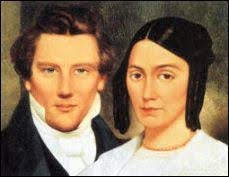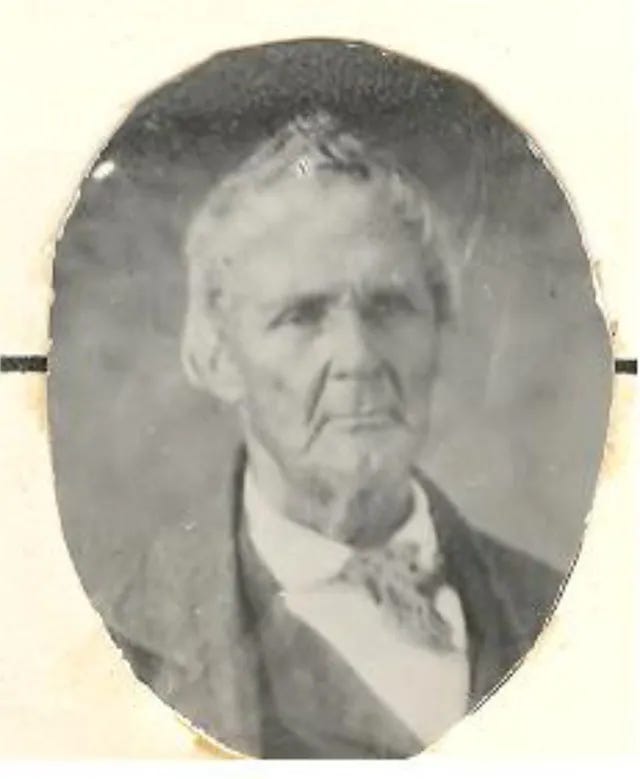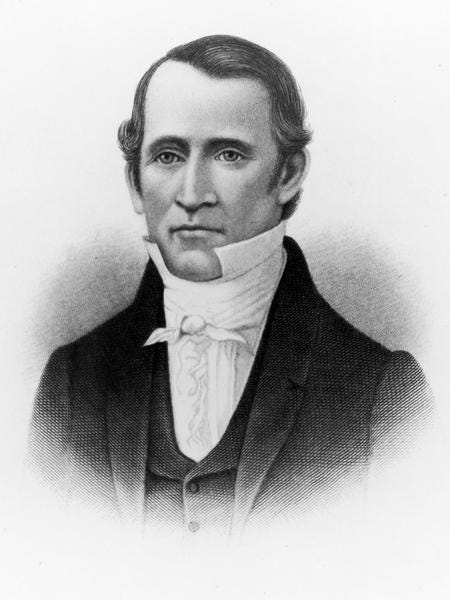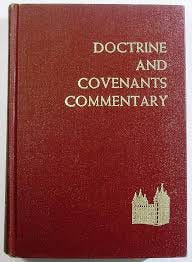Ye Shall Receive My Law
Historical Background and Reflections on Doctrine and Covenants 41
This week we are studying Doctrine and Covenants 41-44, “My Law to Govern My Church.”
Some time in late January, Joseph, Emma, Sidney Rigdon, and Edward Partridge left for Ohio in a sleigh. They arrived in Kirtland on February 1, 1831 and stayed in the house of Newel K. Whitney. As also mentioned in J. Christopher Conkling’s book A Joseph Smith Chronology, Joseph Smith recognized Newel K. Whitney immediately because he had seen him in a vision.
Isaac Morley, a recent convert, had begun to practice having all things in common with his “common stock” farm that he called “the family.” Joseph Smith taught Morley and the Saints “the more perfect law of the Lord” and received Doctrine and Covenants 41 in which Edward Partridge was called to be the first bishop of the Church. (see also here) Soon thereafter, in the presence of twelve elders at Kirtland, Joseph Smith received a revelation that introduced the law of consecration, now contained in Doctrine and Covenants 42. In mid-February of 1831, Joseph Smith received the revelations that are now Doctrine and Covenants 43 and 44, correcting errors that were introduced into the church by a woman named Hubble and a man named Hawley who had been receiving false revelations and causing confusion among the Saints. (See J. Christopher Conkling’s, A Joseph Smith Chronology, pp. 21-22)
Who was Isaac Morley?
Isaac Morley was born in Montague, Massachusetts. In 1812 he married Lucy Gunn, and around this time they settled in Kirtland, Ohio. Morley was baptized into The Church of Jesus Christ of Latter-day Saints in November 1830, and the following year, he allowed Latter-day Saints from New York to settle on his Kirtland farm. In a revelation dated September 1831, Morley was chastised for disobeying the Lord and having evil in his heart (Doctrine and Covenants 64:15–16). From 1831 to 1833, he lived in Independence, Missouri (see Doctrine and Covenants 52:23). While there, he was appointed to organize the branches of the Church in Missouri and serve as a bishop. In the summer and fall of 1835, he accompanied Edward Partridge on a mission to the eastern United States. In 1837, Morley was ordained a patriarch. He moved to Hancock County, Illinois, in 1839. The following year, he was appointed president of the stake at Lima, Illinois. In 1845, he moved to Nauvoo, Illinois. He migrated to Utah in 1848, and he led a settlement of Saints in Sanpete County, Utah, the following year.
References in the Doctrine and Covenants
Let’s examine, to the best of our ability, these revelations in the order in which they were received, outlining the historical context for each section along the way.
Doctrine and Covenants 41 is a revelation that the Prophet Joseph Smith received at Kirtland, Ohio, on February 4, 1831. In this revelation, the Lord instructed His elders to pray to receive God’s law (see section 42). As Bruce R. McConkie also mentions in his section heading, Joseph Smith had just arrived in Kirtland, Ohio from New York, and Leman Copley, another recent convert to the Church requested that “Brother Joseph and Sidney [Rigdon] … live with him and he would furnish them houses and provisions.” In this revelation the Lord clarifies where Joseph and Sidney should live and He calls Edward Partridge to be the Church’s first bishop. (see also here)
In his book The Revelations of the Prophet Joseph Smith, Lyndon W. Cook sheds more light on the background for this section:
Date. 4 February 1831.
Place. Kirtland, Geauga County, Ohio.
Although Kirtland, Ohio, became part of Lake County in 1840, the town was within the boundaries of Geauga County during the 1830s when Joseph Smith received the revelations now found in the Doctrine and Covenants. For this reason Geauga County will be used in this study.
Historical Note. Joseph Smith arrived in Kirtland, Ohio, about 30 January 1831. Section 41, the first of the Doctrine and Covenants revelations received in Ohio, spoke of “my law” soon to be revealed to the Saints and called Edward Partridge to discontinue his life as a merchant and be ordained a bishop.
Accordingly, Partridge, who owned a hatting business in Painesville, Ohio, was ordained a bishop by Sidney Rigdon.
Section 41 also commanded that a house be built for Joseph Smith, in which he was to live and translate the Bible. In later years a house may have been constructed for the Prophet, but by the fall of 1832, only the upper level of the Newel K. Whitney store had been prepared as a residence for the Prophet and his family.
Publication Note. Section 41 was first published as chapter 43 in the Book of Commandments in 1833. (pp. 57-59)
In their book Joseph Smith and the Doctrine and Covenants, Milton V. Backman, Jr. and Richard O. Cowan shed even more light on the background for this section and help us to understand why the Lord prepared the Saints in Ohio to receive His law:
The Prophet Joseph Smith recognized that the Saints were confronted with many problems relating to Church doctrine and administration. All the Saints were new converts, from diverse backgrounds, who brought with them a variety of beliefs and religious behavior. Between February and May 1831, Joseph received at Kirtland, Ohio, eleven revelations relating to proper Latter-day Saint beliefs and practices. Writings of contemporaries provide insights into the challenges that led to those instructions and help us understand the effect they had in the lives of the fledgling Saints.
COMMON STOCK REPLACED BY THE LORD’S LAW
Before their conversions, many of the Saints had been eater to restore primitive Christianity. To this end, they had sought specific guidelines in the New Testament. When they read that early Christians, “had all things common” (Acts 4:32), they organized a system called “common stock,” in which title to all property was held by the group rather than by individuals. The Prophet quickly discerned, however, that what they were doing was not in agreement with the Lord’s will. “The disciples had all things common,” John Whitmer recorded in his history, “and were going to destruction very fast as to temporal things; for they considered from reading the scripture that what belonged to a brother, belonged to any of the brethren. Therefore they would take each other’s clothes and other property and use it without leave which brought on confusion and disappointment, for they did not understand the scripture” (Early History, p. 37) To remedy such problems, the Lord’s first revelation in Ohio promised that he would reveal his “law” and called Edward Partridge to administer it as the Church’s first bishop (D&C 41). Just a few days later, Joseph dictated a portion of what is today Doctrine and Covenants 42, which contains the moral code of the Church and the basic elements of the law of consecration and stewardship. As a result, the Prophet recorded, “the plan of ‘common stock,’ which had existed in what was called ‘the family,’ whose members generally had embraced the everlasting Gospel, was readily abandoned for the more perfect law of the Lord; and the false spirits were easily discerned and rejected by the light of revelation” (History of the Church, 1:146-47). (pp. 53-54)
In her chapter “A Bishop unto the Church” in Revelations in Context, Sherilyn Farnes explains how difficult it must have been for Edward Partridge to learn his new duties as the first bishop of the Church:
On February 4, 1831, upon Partridge’s return to Ohio, Joseph Smith received a revelation (now Doctrine and Covenants 41) calling Edward Partridge as the first bishop in the 10-month-old Church. The office of bishop was one of the first priesthood offices restored in this dispensation, and, like other offices, an understanding of the duties of a bishop came line upon line. Unlike bishops today, Partridge was instructed to not only be “ordained a bishop unto the Church” but also to “leave his merchandise & spend all his time in the labours of the Church.”
With no handbook and no living precedents, Partridge may have wondered what exactly were the “labours of the Church” he was to perform. Fortunately, a few days later, Joseph received a revelation (called “the Law” by early Church members) that contained further information about Partridge’s duties as bishop. (p. 78)
The Lord prepared His Saints to receive His law by revealing what is now D&C 41:
Hearken and hear, O ye my people, saith the Lord and your God, ye whom I delight to bless with the greatest of all blessings, ye that hear me; and ye that hear me not will I curse, that have professed my name, with the heaviest of all cursings.
Hearken, O ye elders of my church whom I have called, behold I give unto you a commandment, that ye shall assemble yourselves together to agree upon my word;
And by the prayer of your faith ye shall receive my law, that ye may know how to govern my church and have all things right before me.
And I will be your ruler when I come; and behold, I come quickly, and ye shall see that my law is kept.
He that receiveth my law and doeth it, the same is my disciple; and he that saith he receiveth it and doeth it not, the same is not my disciple, and shall be cast out from among you;
For it is not meet that the things which belong to the children of the kingdom should be given to them that are not worthy, or to dogs, or the pearls to be cast before swine.
And again, it is meet that my servant Joseph Smith, Jun., should have a house built, in which to live and translate.
And again, it is meet that my servant Sidney Rigdon should live as seemeth him good, inasmuch as he keepeth my commandments.
And again, I have called my servant Edward Partridge; and I give a commandment, that he should be appointed by the voice of the church, and ordained a bishop unto the church, to leave his merchandise and to spend all his time in the labors of the church;
To see to all things as it shall be appointed unto him in my laws in the day that I shall give them.
And this because his heart is pure before me, for he is like unto Nathanael of old, in whom there is no guile.
These words are given unto you, and they are pure before me; wherefore, beware how you hold them, for they are to be answered upon your souls in the day of judgment. Even so. Amen. (D&C 41:1-12)
With the Prophet Joseph Smith, Sidney Rigdon, and Edward Partridge in the front lines, and the Lord going before them, this revelation demonstrates some of the first steps toward creating a true Zion community. The purity of Edward Partridge’s heart, and the willingness of the Lord’s servants to follow and obey Him laid a firm foundation for Zion. It was important for the early Saints to assemble and to unite together in prayer in order to receive the Lord’s law. The Lord governs His Church in His own way and it must be done according to His law.
Once again the Lord reiterates that he will come quickly, and that He will rule over His people when He comes. In this revelation the Lord clearly defines what it means for a person to be His disciple. True disciples of Jesus Christ receive and obey His law. It requires much faith and preparation to receive and obey the law of the Lord. As we study and receive the law of the Lord in the next section, I wonder where in the modern Church of Jesus Christ of Latter-day Saints this law has actually been received and is actually being obeyed. The Temples are symbolic of such consecration, but sadly, from what I have observed in the Church, even these buildings too often serve as a temporary respite from our labors in Babylon.
The Lord prepared specific missions and tasks for his servants. Joseph Smith, the Prophet, Seer, and President of the Church was commissioned to translate the Bible. Sidney Rigdon was commissioned to write for him and to be a spokesman. Edward Partridge was commissioned to administer to the Church as the first bishop. Each had an important role to play in the body of Christ. One of the reasons that the Lord called Edward Partridge as the first bishop of the Church is because his heart was pure before the Lord, and because he was like unto Nathanael of old, without guile. Edward Partridge was pure in heart, which is the primary attribute of the participants in a Zion society. No wonder the Lord began to build His Zion community around Edward Partridge, as well as around others who were pure in heart, such as the Prophet Joseph Smith.
In their commentary on the Doctrine and Covenants, Smith and Sjodahl add interesting insights on this section such as the following:
There were about a hundred members in the Kirtland Branch of the Church, at this time.
In order to understand this Revelation, it may be well to recall the conditions that existed. There was, for instance, a society, sometimes called the Morley Family, because located on the farm of Isaac Morley. They had been baptized, but knew very little about the gospel. “Black Pete,” a negro, was their “revelator.” They claimed to see angels and to receive letters from heaven. There was one Wycom Clark, who claimed to be a revelator, and he organized “The Pure Church.” The Prophet says, “the Branch of the Church in this part of the Lord’s vineyard *** were striving to do the will of God, so far as they knew it, though some strange notions and false spirits had crept in among them. With a little caution and some wisdom, I soon assisted the brethren and sisters to overcome them.” (History of the Church, Vol. I., p. 146.)
… 2. Assemble *** to agree upon my word] Our Lord required of the Saints in Kirtland that they should obey His word; not the word of anyone that claimed to be a revelator. he required the Elders to assemble for the purpose of agreeing upon His word. The wisdom of this is apparent. Impostors succeed best when they can address each individual separately. When a number of persons meet, all desirous of knowing the truth, and praying for truth, the adversary has little chance of deceiving them.
… General Notes
The laws defining the duties of the Bishopric were not yet fully revealed, but in a general way it was understood that the gathering of the Saints was a command for their temporary salvation, and that the office was instituted with this end in view. The Revelation concerning gathering (Sec. 38) also contained more than an intimation of the United Order (vv. 24-27). Orson F. Whitney remarks:
“An order of unity and equality, a system of consecration and stewardships, the abolition of fraud and monopoly in all their phases, a sinking of individual into and for the purpose of the common good, the sacrifice of self at the shrine of principle - of pure religion, whose incense - call it charity, philanthropy, or what we will, is the pure love of God and humanity. It was to the establishment of such an order, - one object of which, in the arcana of the faith, was to pave the way for the Zion of Enoch, which the Saints believe will yet descend to Earth, the planet whence it was taken, - that Joseph Smith, as early as February, 1831, more than fifty years before Edward Bellamy and his ingenious book ‘Looking Backward; were heard of, directed his thoughts and labors. A movement to that end was the organization of the Bishopric, representing the temporal wing of the Mormon Church government. The Apostleship, which pertains to the Priesthood of Melchizedek, through possessing general powers, has a special calling to minister in spiritual things; while the Bishopric, which is the presidency of the Priesthood of Aaron, administers, under the direction of the higher authority, in things temporal” (History of Utah, Vol. I., p. 85). See also Secs. 42:30-52; 51:3-6 and 13-17.
The controversy over the meaning of “Bishop” has never been settled satisfactorily in the world. The New Testament has no office into which the Bishops of the various churches fit, and therefore they are at a loss to explain their duties. They notice that the Bishops in the Bible are sometimes called Elders and sometimes Bishops, and they are confused because they cannot understand how a Bishop can be an Elder. In Eph. 4:11, the Bishops are “Pastors,” or Shepherds, and are placed next to the teachers. This is another puzzle. The fact is, that the Apostles appointed some to superintend the spiritual, and others to have charge of the temporal wants of the churches. The latter were called “Bishops,” which means “overseers.” To the Latter-day Saints, the controversy, in the light of modern revelation, is meaningless. (selections from pp. 215-217)













